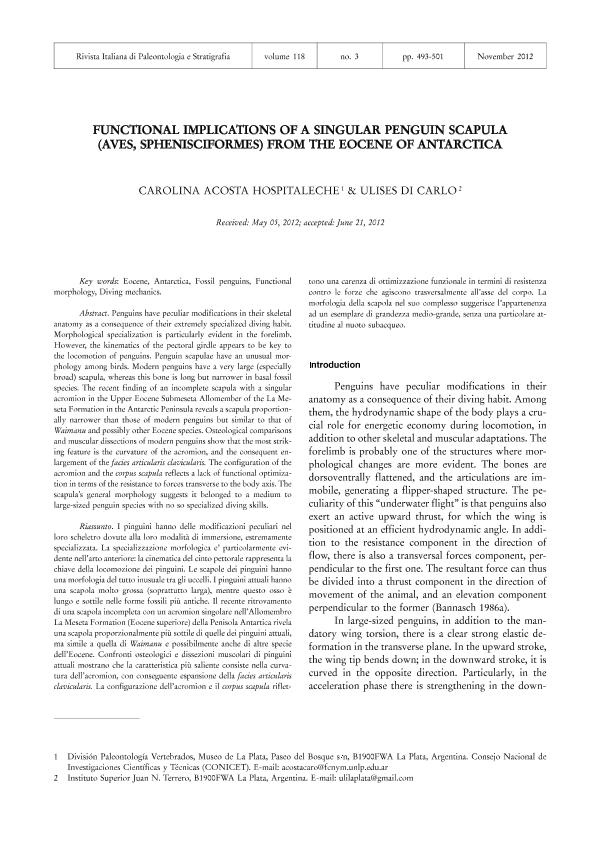Mostrar el registro sencillo del ítem
dc.contributor.author
Acosta Hospitaleche, Carolina Ileana Alicia

dc.contributor.author
Di Carlo, Ulises

dc.date.available
2019-05-09T13:47:08Z
dc.date.issued
2012-03
dc.identifier.citation
Acosta Hospitaleche, Carolina Ileana Alicia; Di Carlo, Ulises; Functional implications of a singular penguin scapula (Aves, Sphenisciformes) from the Eocene of Antarctica; Università degli Studi di Milano; Rivista Italiana Di Paleontologia E Stratigrafia; 118; 3; 3-2012; 493-501
dc.identifier.issn
0035-6883
dc.identifier.uri
http://hdl.handle.net/11336/75949
dc.description.abstract
Penguins have peculiar modifications in their skeletal anatomy as a consequence of their extremely specialized diving habit. Morphological specialization is particularly evident in the forelimb. However, the kinematics of the pectoral girdle appears to be key to the locomotion of penguins. Penguin scapulae have an unusual morphology among birds. Modern penguins have a very large (especially broad) scapula, whereas this bone is long but narrower in basal fossil species. The recent finding of an incomplete scapula with a singular acromion in the Upper Eocene Submeseta Allomember of the La Meseta Formation Peninsula (Antarctica) in the Antarctic Peninsula reveals a scapula proportionally narrower than those of modern penguins but similar to that of Waimanu and possibly other Eocene species. Osteological comparisons and muscular dissections of modern penguins show that the most striking feature is the curvature of the acromion, and the consequent enlargement of the facies articularis clavicularis. The configuration of the acromion and the corpus scapula reflects a lack of functional optimization in terms of the resistance to forces transverse to the body axis.The scapula´s general morphology suggests it belonged to a medium to large-sized penguin species with no so specialized diving skills.
dc.format
application/pdf
dc.language.iso
eng
dc.publisher
Università degli Studi di Milano

dc.rights
info:eu-repo/semantics/openAccess
dc.rights.uri
https://creativecommons.org/licenses/by-nc-sa/2.5/ar/
dc.subject
Spheniscidae
dc.subject
Eocene
dc.subject
Antarctica
dc.subject
Functional Morphology
dc.subject.classification
Meteorología y Ciencias Atmosféricas

dc.subject.classification
Ciencias de la Tierra y relacionadas con el Medio Ambiente

dc.subject.classification
CIENCIAS NATURALES Y EXACTAS

dc.title
Functional implications of a singular penguin scapula (Aves, Sphenisciformes) from the Eocene of Antarctica
dc.type
info:eu-repo/semantics/article
dc.type
info:ar-repo/semantics/artículo
dc.type
info:eu-repo/semantics/publishedVersion
dc.date.updated
2019-05-06T14:39:33Z
dc.journal.volume
118
dc.journal.number
3
dc.journal.pagination
493-501
dc.journal.pais
Italia

dc.journal.ciudad
Milan
dc.description.fil
Fil: Acosta Hospitaleche, Carolina Ileana Alicia. Consejo Nacional de Investigaciones Científicas y Técnicas; Argentina. Universidad Nacional de La Plata. Facultad de Ciencias Naturales y Museo. División Paleontología Vertebrados; Argentina
dc.description.fil
Fil: Di Carlo, Ulises. Instituto Superior Juan N. Terrero; Argentina
dc.journal.title
Rivista Italiana Di Paleontologia E Stratigrafia

dc.relation.alternativeid
info:eu-repo/semantics/altIdentifier/url/https://riviste.unimi.it/index.php/RIPS/article/view/6016
dc.relation.alternativeid
info:eu-repo/semantics/altIdentifier/doi/https://doi.org/10.13130/2039-4942/6016
Archivos asociados
